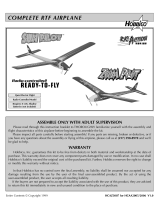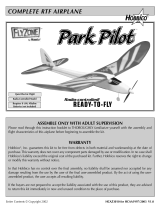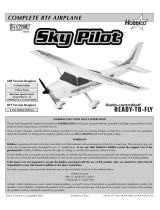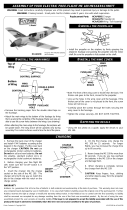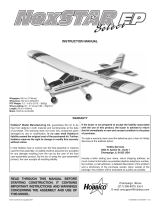Page is loading ...

ASSEMBLE ONLY WITH ADULT SUPERVISION
Please read through this instruction booklet to THOROUGHLY familiarize yourself with the assembly and
flight characteristics of this airplane before beginning to assemble the kit.
Please inspect all parts carefully before starting assembly! If any parts are missing, broken or defective, or if
you have any questions about the assembly or flying of this airplane, please call us at (217) 398-8970 and we'll
be glad to help.
WARRANTY
Hobbico, Inc. guarantees this kit to be free from defects in both material and workmanship at the date of
purchase. This warranty does not cover any component parts damaged by use or modification. In no case shall
Hobbico's liability exceed the original cost of the purchased kit. Further, Hobbico reserves the right to change
or modify this warranty without notice.
In that Hobbico has no control over the final assembly, no liability shall be assumed nor accepted for any
damage resulting from the use by the user of the final user-assembled product. By the act of using the
user-assembled product, the user accepts all resulting liability.
If the buyers are not prepared to accept the liability associated with the use of this product, they are advised
to return this kit immediately in new and unused condition to the place of purchase.
C
C
OMPLETE R
OMPLETE R
TF
TF
AIRPLANE
AIRPLANE
Requires 8 (AA) Alkaline
Batteries (not included)
Quiet Electric Flight
Radio-Controlled Model
Entire Contents © Copyright 2000 HCAZ3004 for HCAA2004 V1.0
™
Aero

Your R/C Action Series plane is not a toy, but rather a
sophisticated, working model that functions very
much like an actual airplane. Because of its realistic
performance, the model, if not assembled and
operated correctly, could possibly cause injury to
yourself and spectators or damage property.
We highly recommend that you get experienced,
knowledgeable help with assembly and during your
first flights, to make your R/C modeling experience
totally enjoyable. You’ll learn faster and avoid risking
your model before you’re truly ready to solo. Your local
hobby shop has information about flying clubs in your
area whose membership includes qualified instructors.
You can also contact the national Academy of Model
Aeronautics (AMA), which has more than 2,500
chartered clubs across the country. Instructor training
programs and insured newcomer training are
available through any one of these clubs.
Contact the AMA at the address or toll-free phone
number below.
Academy of Model Aeronautics
5151 East Memorial Drive
Muncie, IN 47302
(800) 435-9262
Fax: (765) 741-0057
or via the internet at: http://www.modelaircraft.org
1. Assemble the plane according to the instructions.
Do not alter or modify the model. If you make any
modifications, you will void your warranty.
2. Test the operation of the model before each flight
to insure that all equipment is operating properly,
and that the model remains structurally sound.
3. Fly only on calm days (with wind speeds less than
7mph) and in large open areas free of trees, people,
buildings or any other obstacles.
Remember: Take your time and follow the
instructions to end up with a well-built model that is
straight, durable and easy to fly.
The R/C model hobby becomes more and more
enjoyable as your experience grows. Your chances for
success and graduation to higher levels are very good
if you take your time and follow the assembly and
flying instructions carefully and completely. We hope
you enjoy flying your R/C Action Series plane.
Charge the battery before assembling the airplane.
You will need to use the battery to set up the radio
system during assembly.
Charging the battery pack is safe and easy when you
follow these instructions. Before charging, make sure
that all wires and connectors are in good shape and
properly insulated.
1. Plug the included
battery charger into a
110 volt A/C wall outlet.
2. Remove the battery pack from the box. Plug the
battery into the charger connector. Be careful – the
battery will plug in only one way.
3. Allow the battery to charge for 3 hours using the
A/C wall charger.
4. IMPORTANT! NEVER LEAVE A CHARGING
BATTERY UNATTENDED.
5. During charging, feel the battery to see if it is
starting to warm up. A warmed up (but not hot!)
battery pack is a sign that it is fully charged. Once the
pack is warm, disconnect it from the charger.
Depending on how much charge was already in the
pack, you may have to disconnect the battery early.
6. After each flight, remove the battery from the airplane
and allow it to cool completely before recharging.
CHARGING THE NiMH BATTERY PACK
PRECAUTIONS
PROTECT YOUR MODEL, YOURSELF
AND OTHERS.
FOLLOW THIS IMPORTANT SAFETY
PRECAUTION
2

1. Never leave a charging battery unattended.
2. Never let the battery charge until it feels hot. A hot
battery is an overcharged battery. Only let the battery
get warm to the touch.
3. Only use the included charger! A higher rate
charger will charge the pack too quickly and heat up
the wires.
4. A properly cared for battery pack will last a long time.
If the battery pack is continually overcharged or charged
at too high of a rate, the pack will not last long.
ATTENTION: The product you have purchased is
powered by a rechargeable battery. At the end of its
useful life, under various state and local laws, it may
be illegal to dispose of this battery into the municipal
waste system. Check with your local solid waste
officials for details in your area for recycling options
or proper disposal.
This product contains a chemical known to the State
of California to cause cancer and birth defects or
other reproductive harm.
Electronic Speed Control with Auto Cut-off:This unit
controls the speed of the motor. Also it monitors the
battery voltage and turns off the motor so that there
will be enough battery power to operate the radio
while you glide and land the airplane.
Motor: The motor rotates the prop to provide thrust.
NiMH Battery: Rechargeable batteries which are
used as power for the airplane.
Receiver (RX): The radio unit in the airplane which
receives the transmitter signal and relays the control
to the servos.
Servos: The electronic/mechanical device which
moves the control surfaces of the airplane according
to the commands of the transmitter/receiver.
Switch: Turns on the power to the receiver, servos
and motor.
Start Button: With the switch on, pressing the start
button arms the motor. To turn the motor on, move the
throttle lever on the back of the transmitter to the right.
Notice that the motor RPM increases gradually. To turn
the motor off, move the throttle lever to the left.
Transmitter (Tx): This is the hand-held unit that
sends the signal to the receiver. As you move the
stick on the
transmitter, the servos in the airplane will
react
accordingly.
GLOSSARY
BATTERY WARNING
SAFETY PRECAUTIONS FOR
CHARGING BATTERIES
3

Part Name Qty.
❏ 1. Fuselage .......................................1
❏ 2. Main Wing ...................................1
❏ 3. Fin................................................1
❏ 4. Medium Screws............................3
❏ 5. Stabilizer ......................................1
❏ 6. Mini Servo Trays...........................2
❏ 7. Hex Wrench.................................1
❏ 8. Spare Propeller.............................1
❏ 9. Large Screws ................................4
❏ 10. Propeller w/Adapter......................1
❏ 11. Wing Struts...................................2
❏ 12. Medium Screws............................2
❏ 13. Screwdriver ..................................1
❏ 14. Propeller Wrench .........................1
❏ 15. Landing Gear................................2
❏ 16. Landing Gear Cover .....................1
❏ 17. Small Screws ................................4
4
THE RADIO CONTROL SYSTEM
Above is a sketch detailing the layout and function of
the R/C system. It is important to understand the
principles of the system in order to operate your model correctly.
Check the parts against the list below. If any parts are damaged or missing, give us a call at: (217) 398-8970.
1
8
9
2
3
4
5
6
7
17
10
11
12
13
14
15
16

❏ 1. Position the stabilizer on the tail end of the
fuselage. The top of the stabilizer must be flush with the
top of the rectangular fin holder. If it is not flush, remove
the stabilizer and check the two screw holes on the
bottom of the stabilizer for excess foam in the holes.
❏ 2. Secure the stabilizer to the fuselage with two
medium screws. Be careful to not overtighten
the screws.
❏ 3. Insert the fin into the fin holder. Use a medium
screw, inserted through the left side, to secure the fin
to the fin holder.
(If you have the version of the Aero Cruiser with the
radio system already installed, skip to RADIO
ADJUSTMENT.
❏1. Follow the manufacturer's instructions to install the
rubber bushings and metal grommets in both servos.
❏2. If you are installing mini servos in the Aero Cruiser,
attach the two plastic mini servo trays to the standard
servo tray with eight #2 x 3/8” screws (not included).
❏ 3. Use the screws, included with your servos, to
attach the servos to the servo tray. Note that both
servo arm output shafts are towards the front.
❏ 4. Clean the back side of the receiver with rubbing
alcohol. Apply double-sided tape (not included) to
the back of the receiver. Then, install the receiver in
the fuselage.
Note: The wire coming from the speed control is short
to reduce the chance of the speed control causing radio
interference. We recommend that the sockets in the
receiver face forward to avoid strain on the speed
control wire when plugged into the receiver.
RADIO INSTALLATION
INSTALL THE STABILIZER & FIN
5

❏ 5. Plug the pre-installed speed control into the
throttle socket of your receiver, the right servo into the
elevator socket and the left servo into the rudder socket.
❏ 6. Route all of the receiver antenna through the
plastic tube located behind the left servo. Caution:
Do not cut off the excess antenna exiting out the aft
bottom of the fuselage. Cutting the antenna will
reduce the range of the radio system.
❏ 1. Remove the motor battery from the charger.
Open the battery hatch cover on the bottom of the
plane and attach the motor battery, to the connector
from the ESC, inside the battery hatch.
❏ 2. If you are using a radio system that did not
come with the Aero Cruiser, follow the
manufacturer’s instructions to install the batteries in
the transmitter. To install the batteries in the
transmitter included with the Aero Cruiser RTF,
remove the battery cover and battery box from the
bottom of the transmitter and install eight “AA”
batteries in the battery box. Make sure you insert the
batteries according to the diagrams on the battery
box. Reinstall the battery box and cover. Switch on
the transmitter and check the LEDs on the front of the
transmitter. Like a traffic light, green and yellow
mean “GO!” However, if the red LED is glowing, you
need to install fresh batteries.
❏ 3. This is also a good time to make sure that your
radio’s servo reversing switches are correctly set. If
you are using the transmitter included with the Aero
Cruiser, turn the transmitter over. The Ch1 switch
should be set to Norm, Ch2 set to Rev and the Mix
switch set to off. If you are using a radio system not
included with the Aero Cruiser, the servo reversing
will be covered in steps 8 and 9.
RADIO ADJUSTMENT
6

❏ 4. Install the transmitter antenna in the transmitter
by threading it into the top of the transmitter. If you
are using a radio system not included with your Aero
Cruiser, follow the radio manufacturer’s instructions
on installing the transmitter antenna.
❏ 5. Switch on the transmitter and then the airplane.
Center the rudder and elevator trim levers.
❏6. (Aero Cruiser without radio system installed only)
To install the servo arms on the rudder and elevator
pushrods, insert the Z-bends, at the end of the
pushrods, into the servo arms so that the pushrod is
3/8” (9.5mm) from the center of the servo arm. Install
the servo arms on the rudder and elevator servos so
that both arms face the middle. Remember to
reinstall the servo arm screws.
❏ 7. Install the nylon clevises in the outer holes of the
rudder and elevator control horns. With the rudder and
elevator sticks and trims centered, the rudder must be
straight, in-line with the fin and the elevator, straight,
inline with the stabilizer. If they are not, remove the
clevis from the control horn and thread the clevis in or
out until the rudder is aligned with the fin and the
elevator with the stabilizer.
❏ 8. When viewing the airplane from the aft end,
move the rudder stick to the left. The rudder must
move to the left. If it does not, change the position of
the rudder servo reversing switch.
❏ 9. By moving the elevator stick down, the elevator
must move up. If it does not, change the position of
the elevator servo reversing switch.
7

❏ 1. Insert the two landing gear wires in the slot in
front of the battery hatch.
❏2. Position the landing gear cover over the landing
gear and secure it with four small screws. Do not
over-tighten the screws.
❏ 3. Slide the propeller with the propeller adapter
onto the motor shaft. Use the 1.5mm hex wrench to
tighten the set screw against the motor shaft.
❏1. At the front edge of the wing are two small plastic
posts. Position the wing on top of the fuse and slide the
wing forward, inserting the posts in the holes on the
fuselage. Fasten the wing to the fuselage with two large
screws (included in the wrench parts bag). The screws
should be tight enough to hold the wing snug against
the fuselage, yet not crush the wing.
❏2. Turn the airplane over and attach the wing struts to
the two strut supports in the bottom of each of the wings.
❏ 3. Rotate the wing struts so that the end of the strut
is positioned on the bottom of the fuselage. The
INSTALL THE WING
INSTALL THE LANDING GEAR
AND PROPELLER
8

plastic mount on the strut must align with the
mounting hole in the battery hatch. If it does not,
remove the strut and attach it to the strut supports on
the other side of the wing.
❏ 4. Secure the wing struts to the fuselage with
medium screws. Do not over-tighten the screws and
strip out the plastic.
Important: The Aero Cruiser must never be flown
without the wing struts attached. The wing struts help
support the wing.
Note: This section is VERY important and must NOT
be omitted! A model that is not properly balanced
will be unstable and possibly unflyable.
❏Turn the Aero Cruiser over and place marks on the
bottom of the wing 1-7/8” and 2-1/4” back from the
front of the wing, on both sides of the fuselage. Turn
the airplane over. Try balancing the airplane on your
finger tips, between the marks. This is where the
model should balance for your first flights. We also
found that most of our test models balanced at this
point without having to add weight to the nose or
tail. If it does not balance within these marks, weight
will need to be added to the nose or tail. At most
hobby shops, you can purchase self-adhesive lead
weight made specifically for balancing airplanes.
The throws are measured at the widest part of the
elevators and rudder. Adjust the position of the
pushrods at the servo horns and the nylon control
horns to change the amount of throw.
Your transmitter controls the airspeed and direction.
You can go as slow or as fast as you want, but
remember: the faster you fly, the faster your battery
power is used up.
When the battery power gets too low, the “Auto Cut-
Off” feature of the speed control provides an extra
degree of insurance. It reacts to low power by cutting
power to the motor, in effect saving power for the
receiver. That way, your airplane goes into a glide and
you stay in control as you land.
HOW DOES THE AERO CRUISER WORK
We recommend the following control
surface throws:
When the elevator stick is moved all the way down
(towards you) the trailing edge (back edge) of the
elevator should move up 3/8”.
When the elevator stick is moved all the way up
(away from you) the trailing edge (back edge) of
the elevator should move down 3/8”.
When the rudder stick is moved all the way left,
the trailing edge (back edge) of the rudder should
move to the left 1/2”.
When the rudder stick is moved all the way right,
the trailing edge (back edge) of the rudder should
move to the right 1/2”.
SET THE CONTROL THROWS
BALANCE YOUR MODEL
9

It’s best to fly on calm days, when there’s little or no
wind. Also, find an area clear of trees, power lines and
other structures. A flying field for R/C planes is best.
Don’t fly around groups of people, especially children,
or within 6 miles of existing R/C flying fields.
1. Find an open area free of buildings, trees, power
lines and people.
2. For your first few flights, fly only in winds of no
more than 5 miles per hour. After you are
comfortable with the airplane, you can fly in winds
that are no more than 10 miles per hour. If flown in
stronger winds, the plane may be blown down wind
and not have enough power to get back to you.
3. Make sure the motor battery is fully charged and
that the transmitter has good “AA” batteries installed.
4. If others are flying in the same area, make sure that
they are not using the same channel radio system you
are. The back of your transmitter has a tag with a
number on it (for example CH. 16 72.110). This is the
channel frequency you are using.
5. Range check your radio before each flight. Switch
on the transmitter and then the receiver. Do not push
the motor start button during the first part of the radio
range check. With the antenna collapsed, walk 50
feet away from the airplane. Move the rudder and
elevator control stick, checking that the rudder and
elevator move. Now, have a helper hold the airplane,
press the start button and start the motor. Again,
perform the range test with the motor running. If you
still have control over the airplane, it is safe to extend
the antenna and fly the airplane.
If you have never flown an R/C airplane before, we
recommend that you get help from an experienced
R/C pilot. Most R/C clubs have training programs that
will help you learn to fly quickly. If you cannot find
an experienced pilot to help you learn, the following
will help you get your airplane into the air.
1. First, turn your transmitter power switch “ON.”
This immediately puts you in control. Be sure your
throttle lever on the back of the transmitter is all the
way to the left.
2. Now pick up the airplane and switch the airplane on.
3. Press the start button. Caution: Keep your hands
behind the propeller.
4. Move the throttle lever to the right. The propeller
will start to turn. The farther you move the stick, the
faster the propeller will turn.
5. With the throttle lever moved fully to the right,
hand launch the Aero Cruiser into the wind, at a
slight upward angle. Note: For the first couple of
flights, we recommend having a helper hand launch
the airplane. After you become familiar with the
flight characteristic of the airplane, it can be flown off
a hard surface instead of hand launched.
6. Allow the airplane to climb a few seconds before
turning it.
7. When your plane is moving away from you, moving
the rudder stick to the left will make your plane turn to
the left. Moving the rudder stick to the right will make
the plane turn to the right. By adding a little up elevator
(moving the stick towards you) during the turn, the plane
will turn much tighter. Caution: It only requires a small
amount of up elevator.
8. When the plane is coming toward you, moving the
rudder stick left still causes left rudder, but your plane
goes to your right. In short, you have to reverse the
way you control the rudder. Here's a good way to
familiarize yourself with the controls: When the
plane is coming toward you, turn your body so that
FLYING THE AERO CRUISER
PREPARE FOR TAKEOFF
CHOOSE A GOOD FLYING SITE
10

you are facing the same direction the plane is going,
looking over your shoulder at the plane. Now when
you move the rudder stick left, the plane will go to
your left.
9. Now that you have gained some altitude, it is time
to trim the plane for straight level flight. If the plane
wants to climb when the elevator stick is released,
move the elevator trim lever up (away from you). If
the plane wants to dive, move the elevator trim lever
down (toward you). It should require very little trim.
Your goal is to have the plane fly level with the
elevator stick centered.
10. Now, with the plane flying level, check to see if
the plane is flying straight. If it wants to turn when the
rudder stick is centered, move the rudder trim lever
opposite the direction the airplane is turning. The
plane should be trimmed so that if you take your
hands off of the control stick, the plane will fly
straight and level on its own. Having the plane
trimmed properly makes flying much easier and
more enjoyable.
11. Don’t let the airplane get too far away from you.
The farther away it is, the harder it is to see what the
plane is doing.
12. When learning to fly, it is best to keep the plane
high enough so that if you make a mistake, you have
enough altitude to correct the mistake.
It’s a known fact among fellow R/C pilots that your
airplane will land. It is up to you as to where and
how it lands.
1. The Aero Cruiser will get approximately 5 to 10
minutes of flight, at full throttle, on a fully charged
battery before the auto cut-off stops the motor. For
your first couple of flights we recommend that you
attempt to land before the motor stops. This will
allow enough power to abort the landing and try
again if you miss your landing area.
2. During your first flight, while at a high altitude,
turn the motor off and notice how the Aero Cruiser
reacts. This will give you an idea how the plane will
react during a landing.
3. To land the Aero Cruiser, fly down wind, past the
landing area, a few hundred feet. Gently turn into the
wind and reduce the throttle so that the plane starts
to come down. Adjust the throttle as needed to reach
the landing area, but not fly past it.
4. Just before landing, at about 1’ above the ground,
apply a little up elevator to flare (raise the nose of the
plane). This will cause the plane to slow and settle to
the ground.
Switch the airplane and then the transmitter off.
Unplug and remove the motor battery. Allow the
motor battery to cool before recharging. Check the
plane over to make sure nothing has come loose.
REPAIRS
Even the best R/C pilots in the world damage their
planes every now and then. In the unfortunate event
that you damage your airplane, repairs are fairly
simple to make yourself. If there are any cracks in the
wing or fuselage, apply 6-minute epoxy to the
broken area and hold together with clear packaging
tape. Let the glue cure, leaving the tape in place for
added strength.
PART LIST
Replacement parts for your Aero Cruiser
HCAA3320 - Main Wing Set HCAA3321 - Tail Set
HCAA3322 - Fuselage Set HCAA3323 - Cowl
HCAG1030 - 380 Motor HCAG1031 - Motor Mount
HCAM7032 - ESC Set HCAP0119 - AC Wall Charger
HCAP6006 - NiCD BatteryHCAP6007 - NiMH Battery
HCAQ3006 - Landing Gear Set
AFTER THE FLIGHT
Caution: If during a rough landing, the propeller on
the Aero Cruiser should become jammed and
cannot rotate, with the throttle in the run position,
the battery and speed control will become very hot.
Immediately move the throttle lever to the left to
stop the motor. If you fail to do this, the motor,
speed control and/or battery will be damaged.
IT'S NOW TIME TO LAND
11

BUILDING NOTES
Kit Purchased Date:______________________
Where Purchased: _______________________
Date Construction Started: ________________
Date Construction Finished:_______________
Finished Weight:_________________________
Date of First Flight: ______________________
FLIGHT LOG
/
